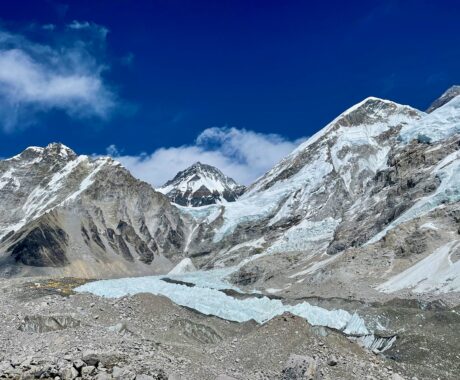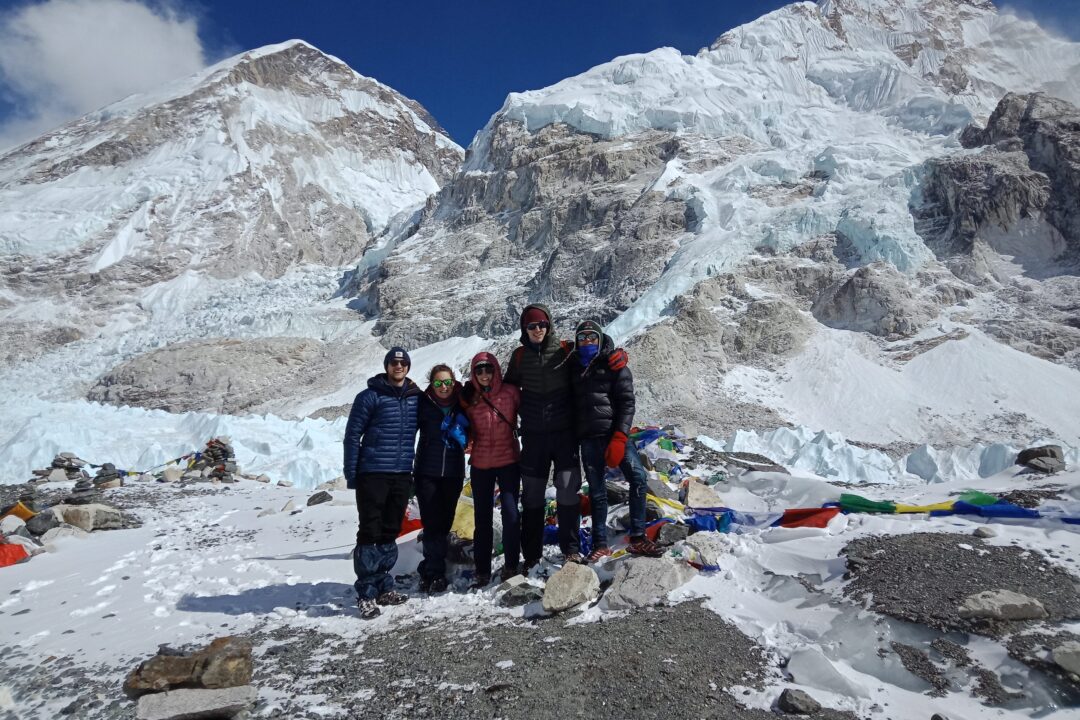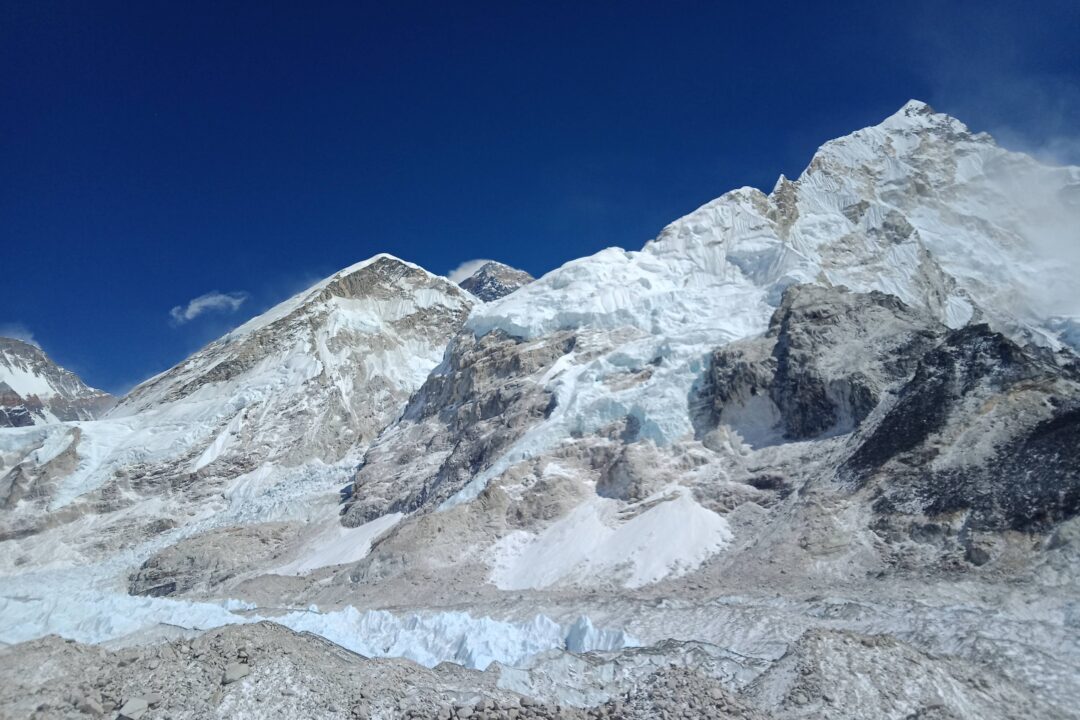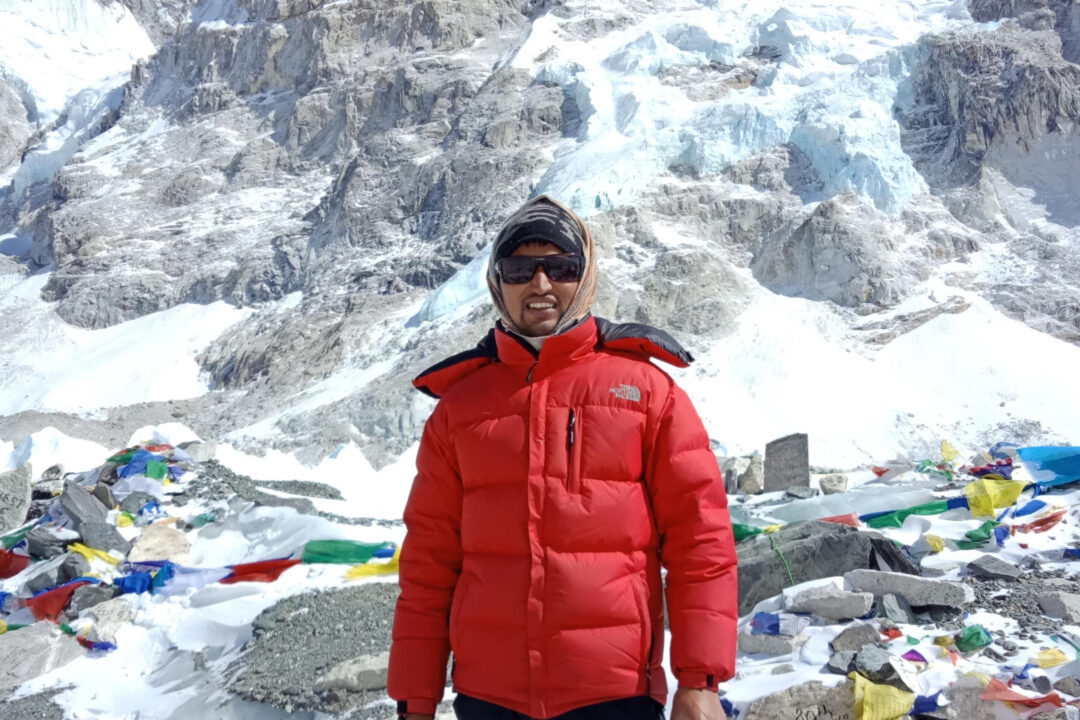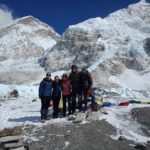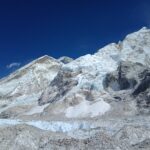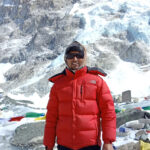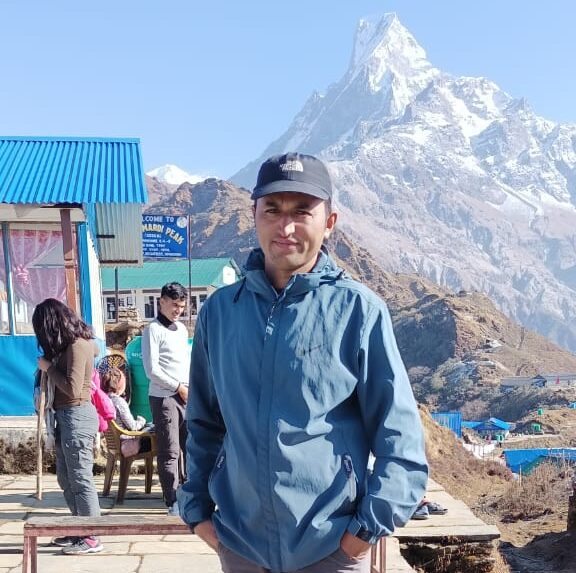Everest Base Camp & Lobuche Peak Climbing
Trip Facts
- Destination Everest Region Nepal
- Activity Climbing Trekking
- Duration 18 Days
- Trip Difficulty moderate_strenuous
- Max. Altitude 6119
- Best Time Sep to Dec & March to May
- Start and End Kathmandu - Kathmandu
- Meals Breakfast / Lunch / Dinner
- Accommodation 5 Star hotel in Kathmandu &Tea house
- Group Size 2 - 10
- Transportation Private transport & Flight Ticket
Trip Highlights
- Combined with the Everest Base Camp Trek
- Heads through the rugged landscape in the Sagarmatha National Park
- Majestic views of world's highest mountain peaks 800m+ - Mt. Everest , Lhotse , Makalu , Cho Oyu , Pumori , Ama Dablam and Mountain Glaciers
- A short Domestic adventurous Himalayan flight from Kathmandu to Lukla
- Exploration of the Sherpa culture, lifestyles and Monasteries
- Aerial view from Everest's summit, Kalapatthar
- Climb in the Himalayas for experience
- Vibrant river gorges and charming settlements are encountered on our ascent via the Khumbu Valley
- Take a tour of Tengboche's historic Buddhist monastery
- Explore verdant alpine woods and picturesque Sherpa settlements
Introduction
The Everest Base Camp trek & Lobuche Peak climbing combine to form a moderately challenging yet immensely rewarding adventure, offering stunning vistas of Everest, Lhotse, Ama Dablam, Nuptse, and Pumori. Lobuche Peak is particularly suited for climbers looking to enhance their skills, featuring steep snow and ice slopes that demand proficient techniques. The journey begins with a scenic 40-minute flight from Lukla, gradually ascending through Phakding to Namche Bazaar, a well-equipped hub in the Everest region. A crucial acclimatization day in Namche prepares climbers for the ascent.
Continuing onward, the route passes through Tengboche and Dingboche, where additional acclimatization stops ensure proper adjustment to altitude. Moving higher, the trail leads to Lobuje, then on to Gorak Shep and finally to the iconic Everest Base Camp. After an overnight stay in Gorak Shep, the return route retraces to Kala Patthar, offering unparalleled views of Everest, a highlight of the trek. Ascending Kala Patthar at 5545m further aids in acclimatization for the peak climbing.
Returning to Lobuje, climbers proceed to Lobuje Base Camp and then advance to the High Camp, the launching point for the Lobuche Peak summit bid. The climb itself is rigorous and technically challenging, but the effort is richly rewarded with awe-inspiring panoramas from the summit.
Outline Itinerary
Day 01: Arrival in Kathmandu pickup to hotel – 1,300m
Day 02: Kathmandu city Sightseeing – 1,300m
Day 03: Fly to Lukla 2,810 m and trek to Phakding 2,610m – 04 hrs
Day 04: Trek to Namche Bazaar 3,450m / 11, 350 feet – 06 hrs
Day 05: At Namche for acclimatization and a short scenic hike – 3,450m
Day 06: Trek to Tengboche 3,867m – 05 hrs
Day 07: Trek to Dingboche 4,400m – 05 hrs
Day 08: Rest day in Dingboche for acclimatization and short excursion -1,300m
Day 09: Trek to Lobuche 4,900m – 05 hrs
Day 10: Trek to Everest Base Camp 5,364m and back to Gorakshep 5,180m – 06 hrs
Day 11: Climb Kalapathar 5,643m / 18,514 feet trek to Lobuche East Base Camp 4,865m / 15,957 feet
Day 12: Rest and spare day preparation for climb to Lobuche East Peak – 4,900m
Day 13: Move to High / Advance Camp 5,600m / 18,368 feet – 03 hrs/Summit bid of Lobuche East Peak and back to base camp.
Day 14: Trek to Pangboche 3, 900m via Pheriche 4,324m – 05 hrs
Day 15: Trek to Namche Bazaar 3,4500m – 06 hrs
Day 16: Trek to Lukla for last overnight stop 2,800m – 06 hrs
Day 17: Fly from Lukla to Kathmandu with afternoon free at leisure – 1,300m
Day 18: International departure for homeward bound – 1,300m
Alternative Treks & Climbs to Everest Base Camp & Lobuche Peak Climbing
If you’re looking for an adventure similar to the Everest Base Camp (EBC) trek with Lobuche Peak climbing but want a different route or a fresh challenge, there are some fantastic alternatives to consider. Whether you’re interested in a higher peak, a quieter trail, or a more technical climb, these options offer an equally breathtaking and rewarding experience in the Himalayas.
- Island Peak & Everest Base Camp Trek – 19 Days: Combine the iconic Everest Base Camp trek with a summit of Island Peak (6,189m), offering an excellent mix of trekking and climbing in the heart of the Himalayas.
- Mera Peak Climbing – 17 Days: For a slightly less technical climb but still an impressive ascent, Mera Peak (6,476m) provides an unforgettable summit experience with panoramic views of some of the highest peaks in the world.
- Everest Three High Passes Trek – 20 Days: This challenging trek takes you over the three high passes—Kongma La, Cho La, and Renjo La—offering unparalleled views of Everest, Lhotse, Makalu, and other peaks, along with a true adventure through the Everest region’s most remote areas.
Detailed Itinerary
-
Day 1: Arrival in Kathmandu pickup to hotel - 1,300m
On arrival at Kathmandu, Nepal International Airport, check the Nepal Standard Time, which is 5 hours and 45 minutes ahead of GMT. Outside the air terminal, our staff from RP Adventures will greet and receive you for a short drive to your hotel. The hotel is located in the hub of Kathmandu; on arrival, check into your lovely rooms. Then meet with other members of the trek for a briefing on Lobuche East Peak Climb and Trekking. After collecting all the useful information and trek details, a group welcome dinner in nice authentic Nepali restaurants was an introduction to Nepali foods and cultures.
Altitude: 1300mMeals: BreakfastAccommodation: 5 Star hotel in Kathmandu -
Day 2: Kathmandu city Sightseeing - 1,300m
A free day in Kathmandu allows for preparation for the treks as well as a tour of Kathmandu and Nepal's famous landmarks. The Kathmandu valley and its adjoining cities are steeped in historical monuments listed as World Heritage Sites. Enjoy the tour of Old Durbar Square, the ancient palace, and the royal courtyard, as well as visiting the oldest Buddhist stupa in Swayambhunath. Additionally, visit the famous Hindu temple of Pashupatinath and the large dome stupa of Bouddhanath before returning to the hotel. After an exciting tour, return to the hotel for the rest of the afternoon to prepare for the Lobuche East Peak Climb and Trek.
Altitude: 1300mMeals: BreakfastAccommodation: 5 Star hotel in Kathmandu -
Day 03: Fly to Lukla 2,810 m and trek to Phakding 2,610m - 04 hrs
Early in the in the morning, for the short flight to Lukla, depart from the hotel on board the small aircraft. The plane takes you high above Kathmandu, facing stunning views of the Himalayan peaks with a panorama of the Kathmandu valley. After a short flight, we landed on the unique runways of Lukla Tenzing and Hillary Airport. At Lukla, take a refreshing break, then start the pleasant walk down to follow the Dudh Koshi River. The walk continues past several villages to reach Phakding for an overnight halt, located on a gorge next to the Dudh Koshi River.
Altitude: 2610mMeals: Breakfast / lunch / DinnerAccommodation: Tea house -
Day 04: Trek to Namche Bazaar 3,450m / 11, 350 feet - 06 hrs
From Phakding to the famous Namche Bazaar, it is quite a long walk of about 6 hours. The distance is not too far, but the altitude gain makes the walk and climb slow. The trail follows a long bridge to Monjo village at the entrance of Sagarmatha National Park. After the park, it is a slow and easy walk to cross another bridge to Jorsalle, the last settlement before Namche Bazaar. After stopping for lunch at Jorsalle, the afternoon walk leads to a high bridge and then to an undulating, winding path up to Namche Bazaar for a two-night stay.
Altitude: 3450mMeals: Breakfast / lunch / DinnerAccommodation: Tea house -
Day 05: At Namche for acclimatization and a short scenic hike - 3,450m
A perfect spot and height for acclimatization, enjoy the day by taking a short hike to the view points. There is a nice museum to collect information on Khumbu Sherpa history and cultures. As well as of flora and fauna and mountaineering history. The high ridge offers grand views of Mt. Everest and its adjoining famous peaks. For energetic people, they can hike to the Everest View Hotel, a climb of a few hours and a great place for views of Everest while enjoying a cup of warm refreshment. The rest of the afternoon, relax and explore Namche Bazaar's main streets, lined with shops, stores, restaurants, and bakeries with fancy hotels and lodges.
Altitude: 3450mMeals: Breakfast / lunch / DinnerAccommodation: Tea house -
Day 06: Trek to Tengboche 3,867m - 05 hrs
The adventure continues from Namche Bazaar, heading higher on the trail, facing tremendous mountain scenery. The walk follows a winding, scenic path down to Phunki Tenga for lunch. In the afternoon, after a few hours of climbing in the cool shade of pine and rhododendron forests, we reach Tengboche and its monastery. At Tengboche, we visit the monastery for a tour of cultural and religious interest and enjoy panoramic views of Everest, Lhotse, and Nuptse. We also get views of Ama Dablam and the range of snow-clad peaks that surround Tengboche, along with its colorful monastery. We stay overnight at a nice lodge in Tengboche with views of the Himalayan peaks.
Altitude: 3900mMeals: Breakfast / lunch / DinnerAccommodation: Tea house -
Day 07: Trek to Dingboche 4,400m - 05 hrs
Enjoying a pleasant overnight in Tengboche with an interesting visit to the monastery, and then the morning walk starts heading downhill. After crossing a bridge, we made a slow climb to Pangboche, the last village before Everest Base Camp. The other places en route are temporary settlements, like Dingboche, Lobuche, and Gorakshep; from Pangboche, walk heads higher. Walking on open and exposed terrain, finally the day ends with reaching Imjatse Valley, where Dingboche is situated. A nice, lovely settlement beneath the towering North Face of Ama Dablam with views of Island Peak, Lhotse, and Nuptse. At Dingboche, transfer to a nice lodge and enjoy the beautiful scenery of the surrounding giant peaks.
Altitude: 4400mMeals: Breakfast / lunch / DinnerAccommodation: Tea house -
Day 08: Rest day in Dingboche for acclimatization and short excursion -1,300m
Another rest day for acclimatization before heading towards our final destination at Everest Base Camp and the climb of Kala Patthar. Enjoy the morning with a scenic hike up to the hill of Nagarjun for spectacular views of the surrounding mountains. Besides Lhotse, Nuptse, and Ama Dablam, get a close look at the famous Island Peak and Mount Makalu towards the east. Spend the rest of the day leisurely in the harmony of the glorious mountain range.
Altitude: 4400mMeals: Breakfast / lunch / DinnerAccommodation: Tea house -
Day 09: Trek to Lobuche 4,900m - 05 hrs
From Dingboche, the adventure continues, heading up and then making a slow, gradual climb to Thukla. Where the trail of Dingboche and Pheriche joins towards Lobuche and Everest base camp, it is an ideal place for a lunch stop. The afternoon leads to a steep climb of less than an hour to Thugla Pass and a ridgetop. This small, flat area is lined with memorials to unfortunate climbers and famous late mountaineers. The walk continues on gently up to Lobuche for an overnight halt, located on a corner of a wide valley.
Altitude: 4900mMeals: Breakfast / lunch / DinnerAccommodation: Tea house -
Day 10: Trek to Everest Base Camp 5,364m and back to Gorakshep 5,180m - 06 hrs
Today's adventure leads us to our first destination, Everest Base Camp. We rise early for a long day ahead. After having breakfast, the walk proceeds northward with a short, steep climb over the moraine of rocks and ice above the Khumbu Glacier. We then descend briefly to Gorakshep, a place adorned with several nice lodges nestled beneath Mt. Pumori and Kalapathar Hill. Continuing en route to Everest Base Camp, after a short rest, we head eastward, following the trail to the base camp at the foot of towering Mt. Everest, Lhotse, and Nuptse. We marvel at the dramatic scenery of arctic-like landscapes filled with rocky moraines, ice, and snow, enjoying close views of the massive Khumbu Icefall just above the base camp. After this wonderful experience, we return to Gorakshep for an overnight stay.
Altitude: 5180mMeals: Breakfast / lunch / DinnerAccommodation: Tea house -
Day 11: Climb Kalapathar 5,643m / 18,514 feet trek to Lobuche East Base Camp 4,865m / 15,957 feet
An early morning climb up to the top of the Kalapathar rocky ridge, the highest point of the trekking. After a good, steep climb, enjoy the eye-catching views of Mt. Everest at close range. Includes a view of Mt. Pumori and a range of giant peaks after a glorious morning. Descend to Gorakshep for breakfast and carry on trekking past Lobuche settlement to Lobuche East Peak Base Camp. Located on a hidden corner just a mere distance from the main trekking trail, enjoy the experience in a tented camp. Lunch and dinner are served by our camping cook and kitchen staff. The rest of the day, enjoy the dramatic scenery.
Altitude: 4900mMeals: Breakfast / lunch / DinnerAccommodation: Camping -
Day 12: Rest and spare day preparation for climb to Lobuche East Peak - 4,900m
Reserved the day to conserve energy after a long, high walk and climb at higher altitudes. Enjoying a rest day to prepare for the final adventure and climb of Lobuche Peak. Allowing time to check climbing gear and practice exercises with our expert guide, as well as scouting the possible safe and accessible route to the top of Lobuche East Peak.
Altitude: 4900mMeals: BreakfastAccommodation: Tea house/Camping -
Day 13: Move to High / Advance Camp 5,600m / 18,368 feet - 03 hrs/Summit bid of Lobuche East Peak and back to base camp.
Morning with leisure time for breakfast, packing only the necessary gear for the climb. Then, heading towards Lobuche High Camp, the climb takes about 3–4 hours to reach above 5,600 m (18,368 feet). The walk follows across a rocky moraine to reach the high camp and set up the camp. Enjoy lunch on the highest spot and relax, as well as plan for the next early climb. Meanwhile, our guide will check the route and pitch the snowbar and ropes where necessary. The big day of the adventure, after breakfast, starts early in the morning to reach the summit. Before the morning cold chill and wind start, the climb requires much technical effort. Using the best of your skill and strength with the support of the guide. Then finally, the climb pushes you on top of Lobuche East Peak Summit, which offers more panoramic views of the mountains. Facing Island Peak, Everest, Lhotse, Nuptse, and Ama Dablam with Cholatse, Pumori, and other closer peaks. After a busy photo session, have a rest and then descend to base camp for lunch and dinner.
Altitude: 4900mMeals: Breakfast / lunch / DinnerAccommodation: Tea house/Camping -
Day 14: Trek to Pangboche 3, 900m via Pheriche 4,324m - 05 hrs
After a mesmerizing adventure climbing the technically challenging Lobuche East Peak and clearing the camp, we left nothing but footprints. After packing up and enjoying our final camping breakfast, we embarked on an easy downhill walk past Thugla to Pheriche Valley for a possible lunch stop. In the afternoon, we walked gradually up and down to a small ridgetop, then descended to Pangboche village for an overnight stay in a cozy lodge with views of Ama Dablam.
Altitude: 3450mMeals: Breakfast / lunch / DinnerAccommodation: Tea house -
Day 15: Trek to Namche Bazaar 3,4500m - 06 hrs
Morning-facing majestic views of Mt. Ama Dablam, Pangboche is located on the main route of Ama Dablam base camp. From Pangboche down to the Imjatse River, climb for an hour or more to Tengboche. Enjoy the magnificent views of the surrounding mountain scenery, then descend downhill to a river at Phunki Tenga. A short drive up to Shanasha village, and then on the winding scenic trail to Namche Bazaar for an overnight stop before Lukla.
Altitude: 3450mMeals: Breakfast / lunch / DinnerAccommodation: Tea house -
Day 16: Trek to Lukla for last overnight stop 2,800m - 06 hrs
Altitude: 2810mMeals: Breakfast / lunch / DinnerAccommodation: Tea house -
Day 17: Fly from Lukla to Kathmandu with afternoon free at leisure - 1,300m
An early start to catch the flight back to Kathmandu; after breakfast, a short walk to Lukla’s Tenzing & Hillary Airport. As the plane arrives from Kathmandu, board a smaller aircraft for a sweeping flight to Kathmandu. On reaching Kathmandu Airport domestic terminal and then transferring back to your hotels, have a free afternoon for individual activities.
Altitude: 1300mMeals: BreakfastAccommodation: 5 Star hotel in Kathmandu -
Day 18: International departure for homeward bound - 1,300m
On your last day in Kathmandu and Nepal, it's time for your international flight. Our RP Adventures guides and staff will transfer you to the airport, where you bid farewell to the guide and staff. Then, you enter the airport terminal for your homeward-bound flight after a great experience and adventure on the Lobuche East Peak Trek and Climb.
Altitude: 1300mMeals: Breakfast
What's included
- International Airport pick up and drop by private vehicle
- 5 Star hotel accommodation in Kathmandu 2 Night (Bed and breakfast included)
- Tea house accommodation (twin-shared basis with attach room) in the trek
- Meals (Breakfast, Lunch, and Dinner) 3Time Tea coffee during the trek
- Kathmandu to Lukla flight Ticket ( Round trip)
- A professional sherpa climbing guide
- A professional trekking guide And porter
- A porter (carry up to 20 kg ) - 1 porter for every 2 trekkers
- Meals, Accommodation, Travel Insurance etc for all our staffs during the trek
- All required permits (Climbing Permit, TIMS, Local Government Taxes, Sagarmatha National Park Permits)
- Tented camp while on Lobuche Peak Climbing.
- All necessary camping equipment , Tent, Table & Chair for climbing expedition's crew's.
- Labuche peak Climbing group climbing gear, climbing rope, snow bars & carabineers etc.
- Basic medical kits
- A trekking map
- A duffel bag to carry all your belongings (should be returned after the trek)
- Rescue arrangement only (must be covered by your travel insurance)
- All Government taxes and official expenses
- Farewell dinner
- RP Adventures T-shirt
What's not included
- International Airfare.
- Your Travel Insurance.
- Rescue & Evacuation.
- Nepal Visa fee (mostly on arrival).
- Lunch and Dinner in Kathmandu.
- Tips for Guide, Porter and Driver
- Drinks and beverage - bottled water / hot water / alcohol.
- Chocolates and sweets.
Trekking Gears
Before you start your journey to Everest Base Camp and Lobuche Peak Climbing, it's important to pack the right clothes and gear and learn about the trekking areas. Most trails in Nepal begin in warm areas and go up to colder ones. To stay safe and comfy during the Everest Base Camp and Lobuche Peak Climbing, it's crucial to bring the right equipment for dealing with the cold. Check out our article on what to pack for the Everest Base Camp and Lobuche Peak Climbing to get all the info you need.
The following basic checklist for trekking and hiking equipment should assist you in packing for our trips. Keep in mind the importance of minimizing the weight of your clothing and gear. Your packed trek bag should weigh less than 15 kilograms. Remember, this is merely a guideline and not everything listed is essential to bring.
- Lightweight thermal gloves
- Hiking boots
- 2 pairs of thin and 2 pair of thick woolen socks.
- Trekking trousers
- Waterproof (trousers / jacket)
- Base layer shirts
- Underwear (4)
- Sun hat or scarf
- Thin, lightweight (inner socks) (4)
- Head lamp ,spare bulbs, & batteries
- Small padlock to lock trek bag
- Plastic bags - for keeping items dry inside trek bag
- Small wash towel
- Basic First Aid Kit
- Sun protection (including total bloc for lips)
- Trekking poles
- Down jacket
- Water bottle 1 liters
- Hand wash
- Snow glasses and sunglasses
- Duffle bag or kit bag to carry to gear while trekking.
Additional Equipment Checklist
- Headband or Beanie
- Swiss army knife
- Lip guard
- Sun lotion
- Scarf or neck Band
- Rain jacket/ Umbrella
Map
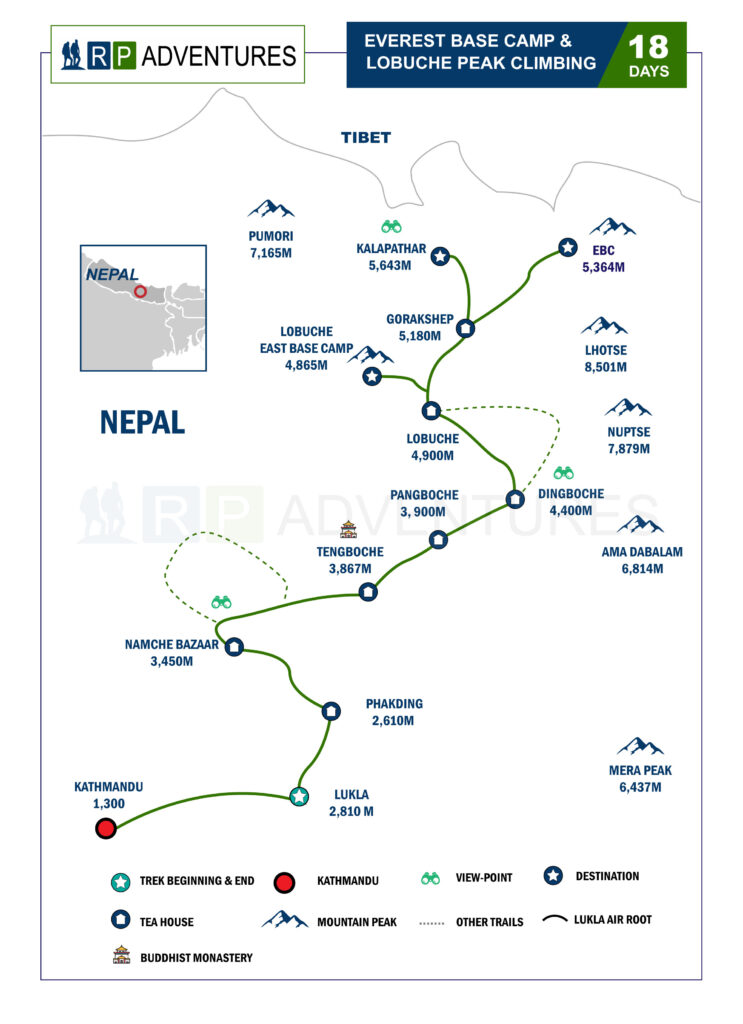
FAQs of Everest Base Camp & Lobuche Peak Climbing
-
Do the flights to and from Lukla operate on time?
Flights to and from Lukla can be subject to delays or cancellations due to weather conditions, particularly in the mountainous terrain. While efforts are made to maintain schedules, passengers should be prepared for potential changes and plan accordingly. Staying updated with airline information and being flexible is advisable. -
What are the procedures if someone becomes critically sick on treks and climbs?
If someone becomes critically sick on treks and climbs, the immediate response is to assess the situation and provide first aid if possible. If the condition is severe, evacuation may be necessary, typically by helicopter in remote areas. Trekkers should have travel insurance that covers emergency evacuation, and guides or authorities will coordinate the rescue operation. -
Do we require travel and medical insurance for peak climbs?
Yes, it is highly recommended to have travel and medical insurance when undertaking peak climbs in Nepal. This insurance provides coverage for emergency medical expenses, evacuation, and other unforeseen circumstances that may arise during the climb, ensuring the safety and well-being of climbers in remote and challenging environments. -
How are the lodge accommodations and food on the Lobuche Peak climb?
The lodge accommodations on the Lobuche Peak climb vary in quality, ranging from basic teahouses to more comfortable lodges with amenities such as hot showers and electricity. Food options typically include a variety of Nepali and international dishes, although choices may be more limited in remote areas. Overall, the quality can vary, but most trekkers find the accommodations and food satisfactory for their needs during the climb. -
What is the popularity and difficulty level of climbing Lobuche East?
The popularity of climbing Lobuche East varies, with many climbers drawn to its challenging routes and stunning views of the Everest region. In terms of difficulty, it is considered a technically demanding climb, requiring prior mountaineering experience and skills such as glacier travel and ice climbing. Proper training and preparation are essential for a successful ascent. -
How much does the Everest Base Camp and Lobuche Peak trek cost?
In general, depending on your budget, time, and interests, the cost can start from $2,500 up to $6,000. -
Can a solo trekker undertake the Everest Base Camp and Lobuche Peak trek?
Yes, in general, depending on your time, budget, and interests, you can undertake a solo trek. -
Where are the Everest Base Camp and Lobuche Peak located?
Everest Base Camp and Lobuche Peak are located south of Tibet and north of the Solukhumbu district. -
What is the best time for trekking and climbing?
Autumn and spring are the best times for trekking and peak climbing. Normally, we recommend spring. -
Is it possible to take a helicopter tour to Everest Base Camp and Lobuche Peak?
Yes, in general, it depends on your time, budget, and interests. -
Can we drink natural water safely during treks in Nepal?
No, it is generally not safe to drink natural water directly during treks in Nepal. It's advisable to treat all water from natural sources or rely on bottled water to prevent the risk of waterborne illnesses. Using water purification tablets or filters can also help make natural water safe for consumption. -
Is it possible to visit Everest Base Camp, Lobuche Peak, Cho La Pass, Gokyo Lakes, Gokyo Ri, and Renjo La Pass at the same time?
Yes, it is possible, depending on your time, budget, and interests, you can undertake the trek and climb. -
What types of animals can we see during the trek?
During the Everest Base Camp and lobuche peak climbing trek, trekkers can encounter various animals, including Himalayan tahr, yaks, marmots, snow leopards, and various species of birds such as Himalayan Monals and vultures. The diverse wildlife enhances the trekking experience in the Himalayas. -
What rivers and lakes do we cross during the trek?
During the Everest Base Camp trek, you may cross several rivers, including the Dudh Kosi River. Additionally, you may come across glacial lakes, with Gokyo Lakes being a notable attraction in the region. -
How high is Tengboche monastery?
Tengboche Monastery is situated in the Himalayas in the upper Khumbu area, standing at an elevation of 3900 meters above sea level. -
When did trekkers start trekking and climbing in the Khumbu region?
Trekkers began climbing and trekking in the Khumbu region of Nepal in the early to mid-20th century. The establishment of trekking routes and the growing popularity of Mount Everest expeditions contributed to the region becoming a major destination for adventure tourism. Sir Edmund Hillary and Tenzing Norgay's historic ascent in 1953 further spurred interest in the area. -
How old is Tengboche Monastery?
It is 400 to 500 years old. -
What kinds of alpine plants and flowers do we encounter during the trek?
During the Everest Base Camp trek, you may encounter various alpine plants and flowers, including rhododendrons, gentians, primulas, saxifrages, and edelweiss. The diverse flora along the trek showcases the unique alpine environment of the region. -
How busy is the route to Everest Base Camp and the climb of Lobuche Peak?
The Everest Base Camp route is a busy trekking area, being the world's highest camp. Lobuche Peak is also a popular destination for peak climbing. -
What type of economy do the people in this area have?
The economy of the people mostly depends on the tourism sector, as it attracts a large number of tourists each year. Eighty percent of the people have a robust economy, enabling them to lead a good lifestyle. -
Where do we meet the climbing guide?
You can meet the climbing guide either in Kathmandu or in Lobuche. -
What types of equipment and gear do we need for the trek?
For a trek in the Khumbu region, essential gear includes sturdy trekking boots, a backpack, layered clothing for varying temperatures, a sleeping bag, trekking poles, a headlamp, sunglasses, a first aid kit, water bottle, navigation tools, personal hygiene items, snacks, and necessary permits. Optional gear may include a tent and cooking stove. -
Can we obtain climbing gear and equipment from Lobuche?
Yes, it is available in Lobuche. -
How high is Lobuche base camp?
The Lobuche Peak base camp is located at 4900 meters above sea level. -
How long does it take to reach summit from Lobuche Base Camp?
Depending on your physical condition, it takes 10 to 15 hours to reach the summit. -
How many nights do we sleep in a tent at Lobuche Base Camp?
Depending on the weather and physical condition, it takes one to three nights in a tent. -
During the EBC and Lobuche Peak climbing, do we hike to Kala Patthar?
Yes, while staying in Gorakshep, we hike to Kala Patthar for either the morning sunrise or the evening sunset and then return. -
What kind of training and exercise are required before undertaking this trek?
Generally, at home, it is suggested to engage in activities such as daily hiking, swimming, gym workouts, and rock climbing. -
What documents are required to undertake this trek and climbing?
We need the original passport, a copy of the passport, passport-sized photos, a copy of the visa, Sagarmatha National Park permit, a local permit, and a climbing special permit. The climbing permit price varies depending on the season. -
Is Sagarmatha National Park a designated World Heritage site?
Yes, it is the world heritage sites. -
Why do place names in the upper Khumbu area end with 'che'?
In the upper Khumbu valley 100 years ago, all the areas such as Namche, Tengboche, Dingboche, Lobuche were originally Yak kharkas. In the Sherpa language, the term 'che' refers to places where animals like Yak, Nyak, and Sheep lived during the summer. That's why every place name in the region is suffixed with 'che'. -
How much should we tip the guide, porter, climbing guide, and kitchen staff?
The agency or guide advises you to deduct 15% of your total budget for the trekking staff. -
Do we need a special permit to undertake a Lobuche Peak climb?
Yes, we need a special climbing permit, climbing guide insurance, and a $500 garbage deposit. -
Why RP Adventures is expensive?
RP Adventures offers an exclusive and high-end trekking experience with its expensive packages. The allure lies in the luxurious accommodations, highly qualified and experienced guides with excellent educational and medical training, ensuring a safe and enriching journey. Private ground transportation adds to the comfort, while the option of helicopter sharing for aerial transport, especially in remote areas, enhances the adventure. The commitment to quality services and safety justifies the elevated cost, providing clients with a truly premium and unforgettable trekking and tour experience. -
Do you have a budget package?
Yes, we offer budget packages for trekking that allow you to choose your own meals. While the trekking routes and permits remain the same, the level of service, including accommodations, food, and guide/porters, varies based on your budget. You can opt for accommodation ranging from 2-star to 5-star hotels, providing flexibility and affordability for your trekking adventure.
Trip You May Like
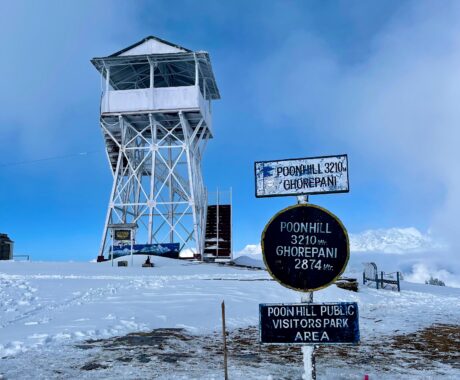
Ghorepani Poon Hill Trek
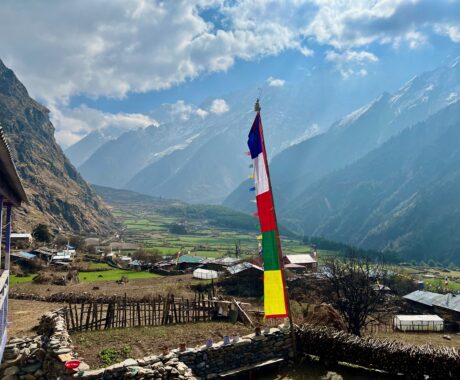
Tsum Valley Trek
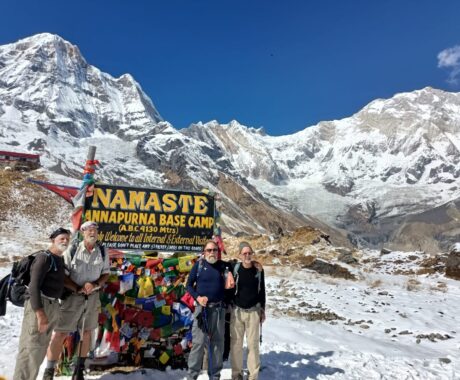
Annapurna Base Camp Trek
